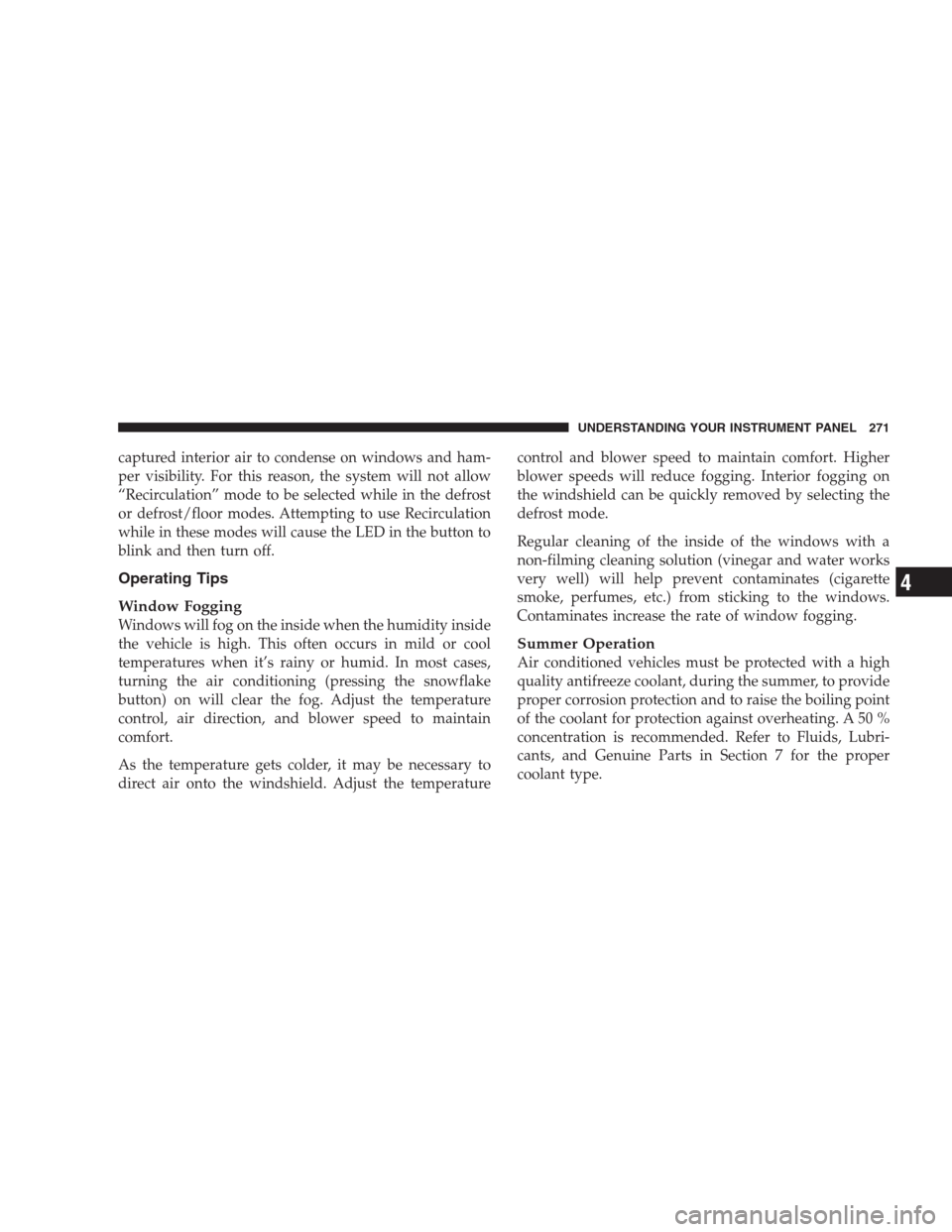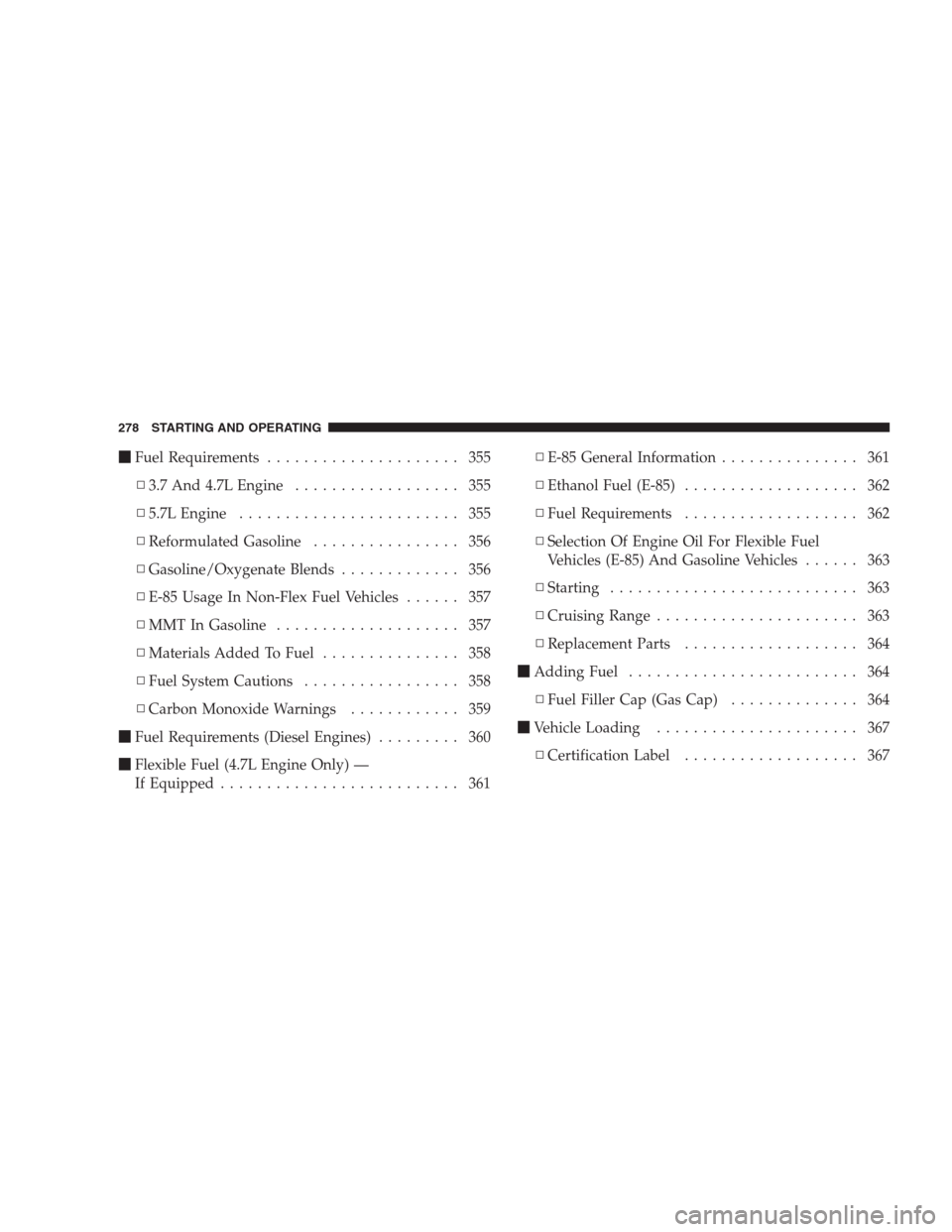Page 198 of 521
•LIFTGATE/HOOD OPEN (with graphic)
•HOOD/GLASS/DOOR OPEN (with graphic)
•HOOD/GLASS/DOORS OPEN (with graphic)
•HOOD/GATE/DOOR OPEN (with graphic)
•HOOD/GATE/DOORS OPEN (with graphic)
•LIFTGLASS/DOOR OPEN (with graphic)
•LIFTGLASS/DOORS OPEN (with graphic)
•LIFTGLASS/HOOD OPEN (with graphic)
•WASHER FLUID LOW (with graphic)
•COOLANT LOW (with graphic)
•OIL CHANGE REQUIRED
•OIL CHANGE RESET
•CHECK GAUGES
•AUTO HIGH BEAMS ON
•AUTO HIGH BEAMS OFF
•PARK ASSIST DISABLED
•SERVICE SUSPENSION
•SERVICE PARK ASSIST SYSTEM
•TRANSMISSION OVER TEMP
•CHECK SHIFT PROCEDURE
•SERVICE 4WD SYSTEM
•4WD SYSTEM IN NEUTRAL
•LOW BRAKE FLUID LEVEL
•WARNING! LIMIT SPEED
•CHECK GASCAP
•ESP OFF
196 UNDERSTANDING YOUR INSTRUMENT PANEL
Page 200 of 521

•PRESS BRAKE TO START
•INSERT KEY
•TURN TO ON
Engine Oil Change Indicator System
Oil Change Required (Gasoline Engines Only)
Your vehicle is equipped with an engine oil change
indicator system. The “Oil Change Required” message
will flash in the EVIC display for approximately 10 sec-
onds after a single chime has sounded, to indicate the
next scheduled oil change interval. The engine oil change
indicator system is duty cycle based, which means the
engine oil change interval may fluctuate, dependent
upon your personal driving style.
Unless reset, this message will continue to display each
time you turn the ignition switch to the ON/RUN
position. To turn off the message temporarily, press andrelease the MENU button. To reset the oil change indica-
tor system (after performing the scheduled maintenance)
refer to the following procedure.
1. Turn the ignition switch to the ON position (Do not
start the engine).
2. Fully depress the accelerator pedal, slowly, three times
within 10 seconds.
3. Turn the ignition switch to the OFF/LOCK position.
NOTE:If the indicator message illuminates when you
start the vehicle, the oil change indicator system did not
reset. If necessary, repeat this procedure.
Trip Functions
Press and release the MENU button until one of the
following Trip Functions displays in the EVIC:
•Average Fuel Economy
•Distance To Empty
198 UNDERSTANDING YOUR INSTRUMENT PANEL
Page 273 of 521

captured interior air to condense on windows and ham-
per visibility. For this reason, the system will not allow
“Recirculation” mode to be selected while in the defrost
or defrost/floor modes. Attempting to use Recirculation
while in these modes will cause the LED in the button to
blink and then turn off.
Operating Tips
Window Fogging
Windows will fog on the inside when the humidity inside
the vehicle is high. This often occurs in mild or cool
temperatures when it’s rainy or humid. In most cases,
turning the air conditioning (pressing the snowflake
button) on will clear the fog. Adjust the temperature
control, air direction, and blower speed to maintain
comfort.
As the temperature gets colder, it may be necessary to
direct air onto the windshield. Adjust the temperaturecontrol and blower speed to maintain comfort. Higher
blower speeds will reduce fogging. Interior fogging on
the windshield can be quickly removed by selecting the
defrost mode.
Regular cleaning of the inside of the windows with a
non-filming cleaning solution (vinegar and water works
very well) will help prevent contaminates (cigarette
smoke, perfumes, etc.) from sticking to the windows.
Contaminates increase the rate of window fogging.
Summer Operation
Air conditioned vehicles must be protected with a high
quality antifreeze coolant, during the summer, to provide
proper corrosion protection and to raise the boiling point
of the coolant for protection against overheating. A 50 %
concentration is recommended. Refer to Fluids, Lubri-
cants, and Genuine Parts in Section 7 for the proper
coolant type.
UNDERSTANDING YOUR INSTRUMENT PANEL 271
4
Page 280 of 521

�Fuel Requirements..................... 355
▫3.7 And 4.7L Engine.................. 355
▫5.7L Engine........................ 355
▫Reformulated Gasoline................ 356
▫Gasoline/Oxygenate Blends............. 356
▫E-85 Usage In Non-Flex Fuel Vehicles...... 357
▫MMT In Gasoline.................... 357
▫Materials Added To Fuel............... 358
▫Fuel System Cautions................. 358
▫Carbon Monoxide Warnings............ 359
�Fuel Requirements (Diesel Engines)......... 360
�Flexible Fuel (4.7L Engine Only) —
If Equipped.......................... 361▫E-85 General Information............... 361
▫Ethanol Fuel (E-85)................... 362
▫Fuel Requirements................... 362
▫Selection Of Engine Oil For Flexible Fuel
Vehicles (E-85) And Gasoline Vehicles...... 363
▫Starting........................... 363
▫Cruising Range...................... 363
▫Replacement Parts................... 364
�Adding Fuel......................... 364
▫Fuel Filler Cap (Gas Cap).............. 364
�Vehicle Loading...................... 367
▫Certification Label................... 367
278 STARTING AND OPERATING
Page 284 of 521
release it as soon as the starter engages. The starter motor
will disengage automatically in 10 seconds. Once this
occurs, release the accelerator pedal, turn the ignition
switch to the LOCK position, wait 10 to 15 seconds, then
repeat the normal starting procedure.
CAUTION!
To prevent damage to the starter, wait 10 to 15 sec-
onds before trying again.
After Starting
The idle speed is controlled automatically and it will
decrease as the engine warms up.
Normal Starting — Diesel Engines
Observe the following when the engine is operating.
•All message center lights are off.
•Malfunction Indicator Light (MIL) is off.
•Low Oil Pressure Light is off.
Cold Weather Precautions
Operation in ambient temperature below 32°F (0°C) may
require special considerations. The following chart sug-
gests these options.
*No. 1 Ultra Low Sulfur Diesel Fuel (ULSD) should only
be used where extended arctic conditions (-10°F/-23°C)
exist.
282 STARTING AND OPERATING
Page 286 of 521

depending on engine temperature. When the “Wait To
Start” goes out, the engine is ready to start.
4. Tip Start Feature
Do notpress the accelerator. Use the Fob with Integrated
Key (FOBIK) to briefly turn the ignition switch to the
START position and then release it. The starter motor will
continue to run, and it will automatically disengage
when the engine is running. If the engine fails to start, the
starter will disengage automatically in 20 seconds. The
starter can be disengaged by turning the ignition key to
the OFF position, if required.
5. After the engine starts, allow it to idle for approxi-
mately 30 seconds before driving. This allows oil to
circulate and lubricate the turbocharger.
Avoid prolonged idling in ambient temperatures below
0°F (-18°C). Long periods of idling may be harmful to
your engine because combustion chamber temperatures
can drop so low that the fuel may not burn completely.Incomplete combustion allows carbon and varnish to
form on piston rings and injector nozzles. Also, the
unburned fuel can enter the crankcase, diluting the oil
and causing rapid wear to the engine.
Engine Warm-Up
Avoid full throttle operation when the engine is cold.
When starting a cold engine, bring the engine up to
operating speed slowly to allow the oil pressure to
stabilize as the engine warms up.
NOTE:High-speed, no-load running of a cold engine
can result in excessive white smoke and poor engine
performance. No-load engine speeds should be kept
under 1,200 RPM during the warm-up period, especially
in cold ambient temperature conditions.
If temperatures are below 32°F (0°C), operate the engine
at moderate speeds for five minutes before full loads are
applied.
284 STARTING AND OPERATING
Page 287 of 521

Engine Idling - In Cold Weather
Avoid prolonged idling in ambient temperatures below
0°F (-18°C). Long periods of idling may be harmful to
your engine because combustion chamber temperatures
can drop so low that the fuel may not burn completely.
Incomplete combustion allows carbon and varnish to
form on piston rings and injector nozzles. Also, the
unburned fuel can enter the crankcase, diluting the oil
and causing rapid wear to the engine.
Stopping The Engine
Before turning off your turbo diesel engine, always allow
the engine to return to normal idle speed and run for
several seconds. This assures proper lubrication of the
turbocharger. This is particularly necessary after any
period of hard driving.
Idle the engine a few minutes before routine shutdown.
After full load operation, idle the engine three to five
minutes before shutting it down. This idle period willallow the lubricating oil and coolant to carry excess heat
away from the combustion chamber, bearings, internal
components, and turbocharger. This is especially impor-
tant for turbocharged, charge air cooled engines.
ENGINE BLOCK HEATER — IF EQUIPPED
The engine block heater warms the engine, and permits
quicker starts in cold weather. Connect the heater cord to
a ground-fault interrupter protected 110-115 Volt AC
electrical outlet with a grounded, three-wire extension
cord.
Use the heater when temperatures below 0°F (-18°C) are
expected to last for several days.
The block heater must be plugged in at least one hour to
have an adequate warming effect on the coolant.
The engine block heater cord is located:
•3.7L/4.7L Engine — coiled and strapped to the engine
oil dipstick tube.
STARTING AND OPERATING 285
5
Page 305 of 521

Flowing Water
If the water is swift flowing and rising (as in storm
run-off) avoid crossing until the water level recedes
and/or the flow rate is reduced. If you must cross
flowing water avoid depths in excess of 9 in (23 cm). The
flowing water can erode the streambed causing your
vehicle to sink into deeper water. Determine exit point(s)
that are downstream of your entry point to allow for
drifting.
Standing Water
Avoid driving in standing water deeper than 20 in
(51 cm), and reduce speed appropriately to minimize
wave effects. Maximum speed in 20 in (51 cm) of water is
less than 5 mph (8 km/h).
Maintenance
After driving through deep water, inspect your vehicle
fluids and lubricants (engine oil, transmission oil, axle,transfer case) to assure the fluids have not been contami-
nated. Contaminated fluid (milky, foamy in appearance)
should be flushed/changed as soon as possible to pre-
vent component damage.
Driving In Snow, Mud And Sand
In heavy snow, when pulling a load, or for additional
control at slower speeds, shift the transmission to a low
gear and shift the transfer case to 4WD LOW if necessary.
Refer to “Four-Wheel Drive Operation” in this section.
Do not shift to a lower gear than necessary to maintain
forward motion. Over-revving the engine can spin the
wheels and traction will be lost.
Avoid abrupt downshifts on icy or slippery roads, be-
cause engine braking may cause skidding and loss of
control.
STARTING AND OPERATING 303
5